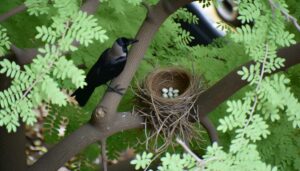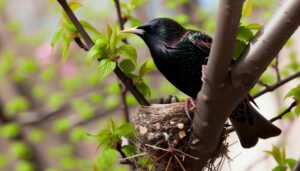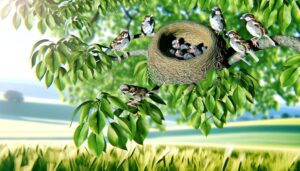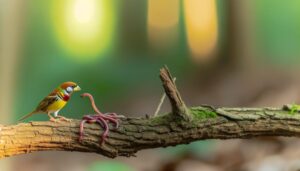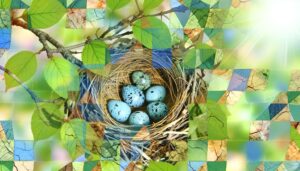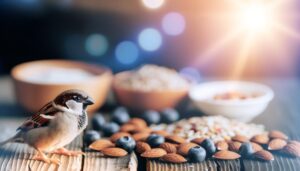When Can Any Sparrow Days Old Eat Bird Food?
Sparrows generally begin to eat bird food around 14 to 17 days old. This period marks the completion of their feather growth, which is essential for thermal regulation and flight readiness.
At this stage, their motor skills and coordination are sufficiently developed to start shifting from regurgitated food provided by parents to more solid foods. Gradual introduction to a varied diet, rich in proteins, amino acids, and fatty acids, is vital.
They still depend primarily on insects for protein. For more insights into monitoring eating habits and encouraging self-feeding behaviors, further information is available.
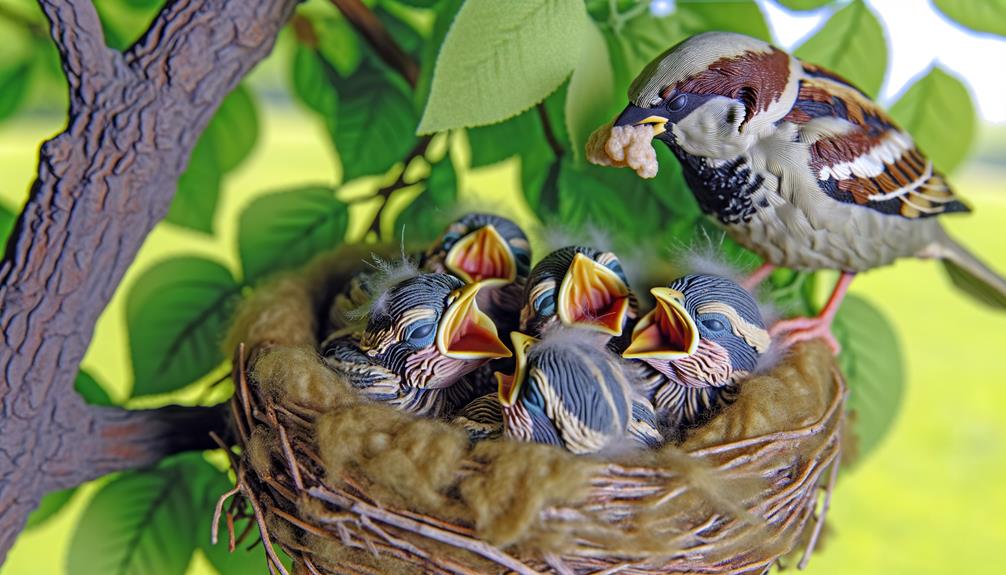
Key Takeaways
- Sparrows typically begin eating solid bird food around 14-17 days old when they have complete feathering.
- Nutritional dependency on regurgitated food is crucial during the hatchling and first week stages.
- Parent sparrows intensively feed their young protein-rich insects to support growth.
- Sparrows develop motor skills and coordination needed for independent feeding by the fledgling transition stage.
- Gradual introduction of solid food is essential to stimulate foraging instincts and self-feeding behaviors.
Sparrow Hatchling Stage
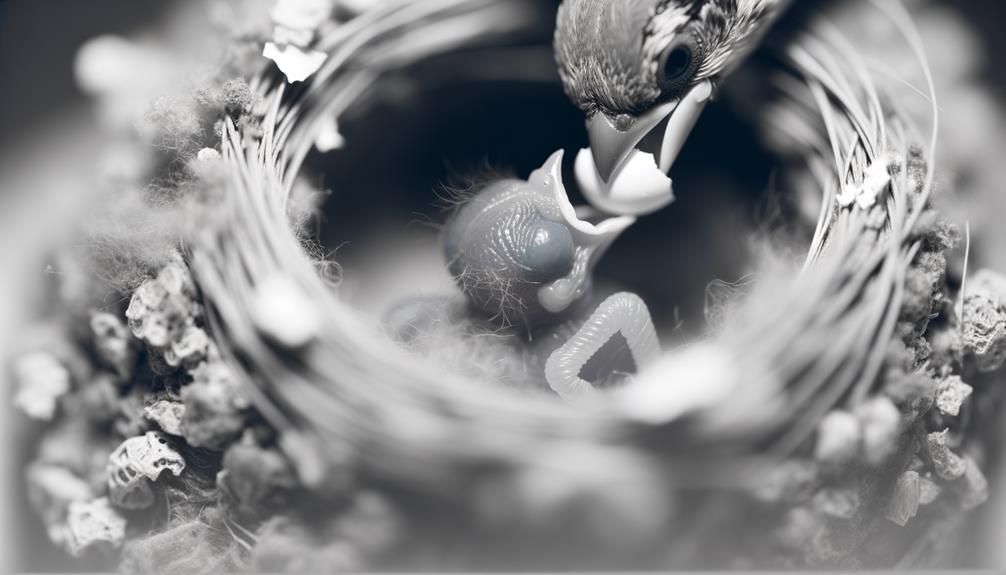
The sparrow hatchling stage, which spans from hatching to approximately 5 days old, is characterized by rapid growth and dependency on parental care for nourishment. During this pivotal period, hatchlings are altricial, meaning they are born blind, featherless, and entirely dependent on their parents for survival.
Their primary diet consists of regurgitated food, usually invertebrates, which the parents provide to meet their high nutritional demands. Nutrient absorption is paramount at this stage to support rapid tissue development and metabolic needs. The parents' role in providing frequent feedings guarantees the hatchlings' successful progression through this vulnerable phase.
Observations indicate that the hatchlings' physical and behavioral development during these first days is essential for subsequent stages of growth and independence.
First Week Development
During the first week of development, sparrow hatchlings undergo significant physiological and behavioral changes that are essential for their survival and future independence. These changes are marked by rapid growth and necessary adaptations that lay the foundation for subsequent stages.
- Feather Development: Initial appearance of down feathers, which provide vital warmth and protection.
- Sensory Maturation: Gradual opening of eyes and enhancement of auditory senses, allowing better interaction with the environment.
- Nutritional Dependency: High metabolic rates necessitating frequent feedings, mainly from parental regurgitation.
- Motor Skills: Developing basic motor functions, such as head lifting and beak opening, important for feeding and communication.
These milestones are crucial in ensuring that sparrow hatchlings are prepared for the next stages of growth.
Parent-Feeding Period
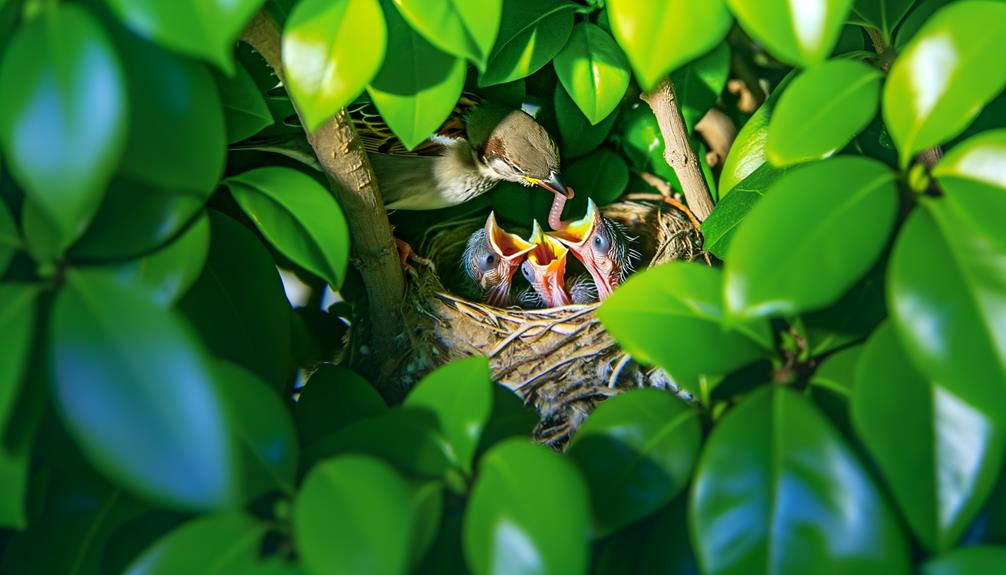
Parent-feeding period in sparrows is characterized by a pivotal phase where the hatchlings rely entirely on adult birds for nutrition, which is essential for their continued growth and development. This period typically spans from hatching until approximately 14 days old.
During this time, adult sparrows deliver a diet mainly consisting of insects and other protein-rich food sources to the nestlings. These nutrients are vital for the rapid cellular growth and energy demands of the developing chicks. While both parents participate in feeding, the frequency and quantity of food deliveries increase as the nestlings age.
This intensive feeding behavior ensures that the young sparrows accumulate the necessary resources to progress into the next stages of development effectively.
Feather Growth Milestones
Feather growth in sparrows is marked by distinct developmental stages that are crucial for their survival and flight capabilities. These stages encompass intricate processes of feather formation, growth, and physiological changes.
Initially, the pin feathers emerge, which are necessary for insulation and protection.
Key milestones include:
- Pin Feathers Emergence: Appears within the first few days post-hatching.
- Feather Sheath Development: Provides structural support and protection to developing feathers.
- Sheath Breakage and Feather Unfurling: Occurs around the second week, allowing feathers to expand.
- Complete Feathering: By approximately 14-17 days, feathers are fully developed for initial flight attempts.
Each phase is essential, ensuring the sparrow achieves adequate thermal regulation, camouflage, and eventual flight capability. This systematic progression underscores the importance of each feather growth stage in a sparrow's lifecycle.
Fledgling Transition
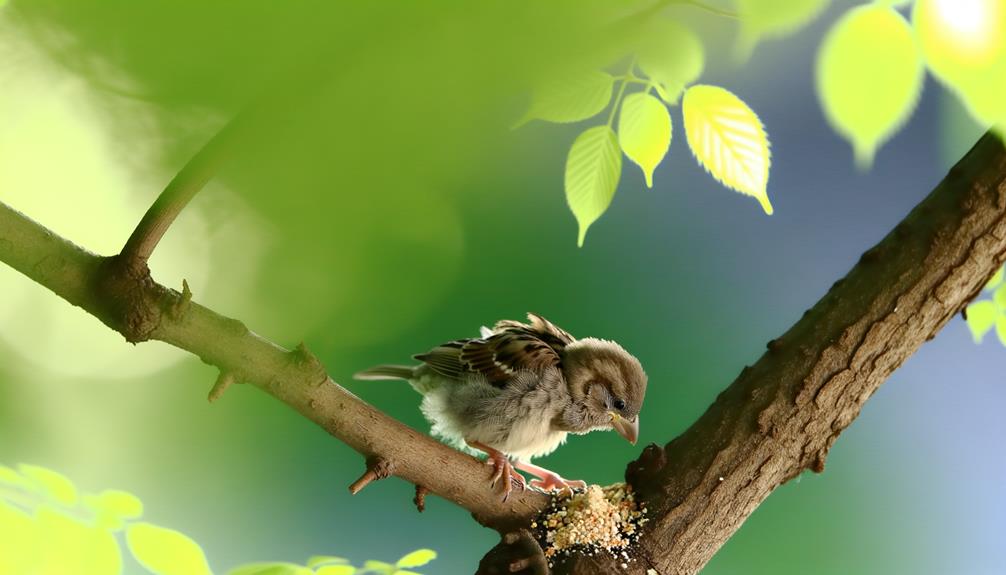
The fledgling phase is a critical stage in the life of a sparrow, marked by significant developmental milestones that prepare the bird for independence.
During this period, fledglings exhibit increased motor skills and coordination, enabling their initial attempts at independent feeding.
Observational data indicate that sparrows typically begin this phase between 14 to 17 days post-hatching, showcasing their readiness to consume solid bird food.
Developmental Milestones
Around day 12 post-hatching, sparrow nestlings begin to exhibit significant developmental milestones that mark their shift to fledglings capable of consuming bird food independently. These milestones are vital for their survival and further growth, signaling readiness for more autonomous behaviors.
Feather Development:
Nestlings' feathers become more robust, providing better insulation and enabling flight practice.
Increased Mobility:
Fledglings start to exhibit improved coordination and strength, evident in their ability to hop around the nest.
Vocalization Changes:
Vocal patterns evolve to include more complex calls, aiding communication with parents and siblings.
Eye Clarity and Alertness:
Enhanced visual acuity and responsiveness to environmental stimuli are observed, essential for spotting food and predators.
These indicators collectively denote the fledglings' developmental readiness for the next stage of life.
First Independent Feeding
Achieving the milestone of first independent feeding, fledgling sparrows demonstrate the culmination of their early developmental progress and the onset of self-sustained nourishment behaviors. Typically occurring between 14 to 17 days post-hatching, this phase marks a critical shift from parental dependency to autonomous foraging.
During this period, fledglings exhibit significant behavioral changes, such as pecking at seeds and insects, indicative of innate feeding instincts. The fledgling's ability to recognize and consume appropriate food sources is paramount for survival, necessitating rigorous observation of their environment and mimicking of adult sparrows.
This self-sufficiency in feeding not only fosters physical growth but also enhances cognitive development, preparing the young sparrows for subsequent challenges in their ecological niche.
First Attempts at Eating
At approximately 10 to 14 days old, sparrow chicks begin their initial attempts at consuming bird food independently, a critical developmental milestone that requires careful observation and analysis. During this period, several physiological and behavioral changes are evident. These first attempts are marked by the chick's gradual shift from parent-fed nutrition to self-feeding, which is essential for their growth and survival.
Key observations during this stage include:
- Coordination Development: Enhanced motor skills enable chicks to peck at food more effectively.
- Nutritional Adaptation: The digestive system begins adjusting to solid foods, essential for proper nutrient absorption.
- Behavioral Shifts: Increased curiosity and interaction with the environment signal readiness for independent feeding.
- Parental Role: Parents still provide guidance and supplementary feeding during this pivotal phase.
These factors collectively signify the chick's readiness for subsequent feeding stages.
Introducing Bird Food
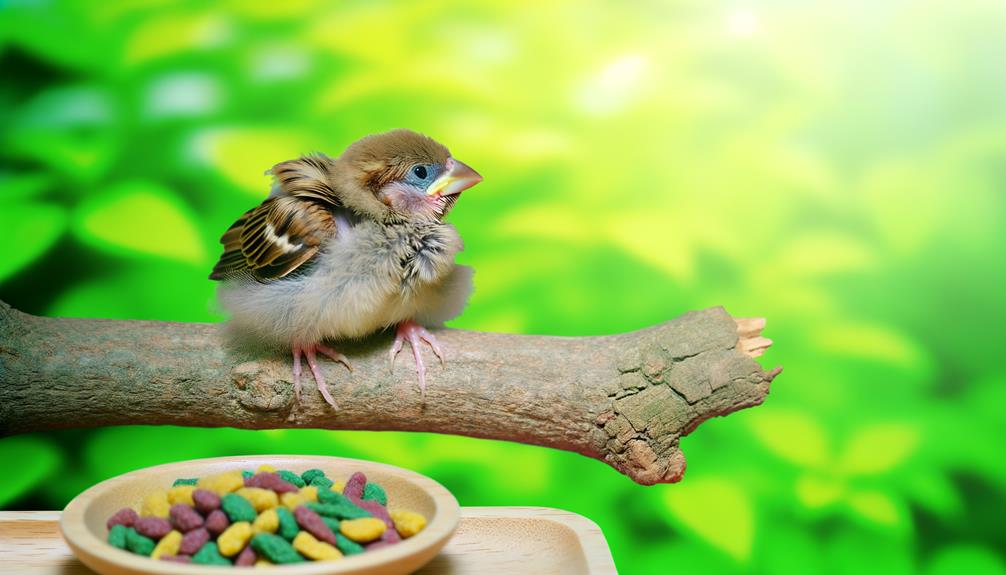
Introducing bird food to young sparrows requires a careful consideration of the types of bird food available, their specific nutritional requirements, and effective feeding techniques.
It is vital to analyze the nutritional composition of various foods to guarantee they meet the developmental needs of the sparrows.
Additionally, the method of presenting the food plays a significant role in facilitating the shift from parental feeding to independent consumption.
Types of Bird Food
Various kinds of bird food provide necessary nutrients crucial for the healthy growth and development of sparrows. Seeds, insects, and suet are among the options available. Each kind of food offers specific benefits tailored to different stages of a sparrow's life. For instance, seeds are rich in carbohydrates and essential fatty acids, while insects supply protein and important amino acids. Suet, a high-energy food, is particularly beneficial during colder months when other food sources are scarce.
Nutritional Requirements
Understanding the specific nutritional requirements of sparrows at different stages of their development is necessary for providing appropriate bird food that supports their growth and overall health. Newly hatched sparrows initially rely on regurgitated food from their parents, rich in proteins and fats important for rapid development.
As they progress from nestlings to fledglings, their diet diversifies to include seeds, insects, and fruits, necessitating a balanced intake of carbohydrates, vitamins, and minerals. Protein remains an essential component, supporting muscle and feather development. Essential amino acids and fatty acids, particularly omega-3 and omega-6, are crucial for neurological development and immune function.
Ensuring a well-rounded diet during these stages is crucial for fostering robust physiological and cognitive growth in sparrows.
Feeding Techniques
Shifting sparrows from a diet of regurgitated food to independently consumed bird food requires a methodical approach that considers their developmental stage, beak morphology, and digestive capability. Initially, soft and easily digestible foods should be introduced to mimic the texture of regurgitated feed. Gradually, more textured foods can be included as the bird matures.
Key steps in this progression include:
- Observation: Monitor the sparrow's beak strength and feeding behavior to determine readiness for solid food.
- Gradual Introduction: Start with semi-solid foods before moving to harder textures.
- Nutritional Balance: Ensure the diet includes essential nutrients to support growth.
- Consistency: Maintain a consistent feeding schedule to establish routine and ease the progression.
This structured approach guarantees the sparrow adapts efficiently.
Encouraging Self-Feeding
Encouraging self-feeding in young sparrows requires a well-timed introduction of appropriate bird food, coupled with environmental modifications that promote independent eating behaviors. Typically, sparrows begin showing interest in solid food around 14-16 days old.
At this stage, offering a variety of finely crushed seeds or soft, insect-based foods can stimulate their natural foraging instincts. Ensuring the feeding area is easily accessible and free from potential stressors is vital. Gradually reducing hand-feeding and placing food in shallow dishes or scattered on the ground can further encourage self-reliance.
Additionally, observing flock dynamics where older, self-feeding sparrows model feeding behaviors can be beneficial. This methodical approach fosters the shift from dependency to autonomy, optimizing the sparrows' developmental trajectory.
Monitoring Eating Habits
As young sparrows begin to explore self-feeding, systematically monitoring their eating habits becomes critical to guarantee they are meeting their nutritional needs and progressing towards full independence. Observing dietary intake can reveal crucial information about a sparrow's health and development. Key factors include frequency and quantity of food consumption, as well as the variety of food types ingested. By tracking these metrics, one can identify potential deficiencies or overconsumption patterns early.
- Frequency of Feeding: Document how often the sparrow eats to confirm regular intervals.
- Volume of Intake: Measure the amount of food consumed to verify adequate nutrition.
- Food Diversity: Monitor the types of food eaten to ensure a balanced diet.
- Behavioral Changes: Note any alterations in feeding habits indicating health issues.
Conclusion
In the intricate dance of avian development, sparrows journey from helpless hatchlings to self-sufficient fledglings, moving through milestones of growth with precision.
Their journey to self-feeding, typically commencing around two weeks, marks a critical shift from parental sustenance to autonomy.
Observing their dietary changes provides a window into the broader symphony of nature's cycles.
By understanding these stages, insights into avian life and broader ecological dynamics are gathered, enriching scientific knowledge and fostering conservation efforts.

